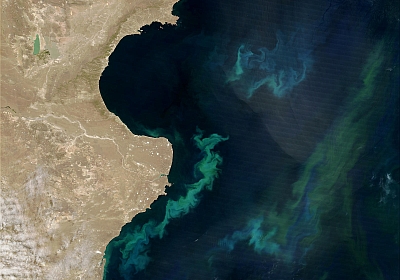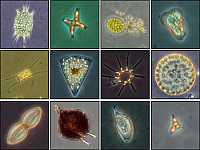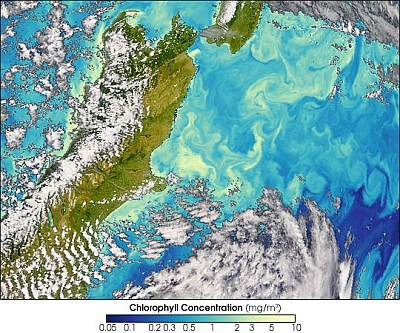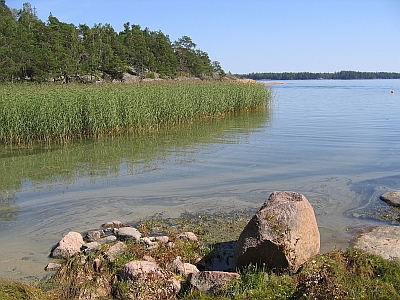When do they occur? and How do they develop?
One of the main goals of remote-sensing observations of algal blooms is the study of seasonal cycles
of phytoplankton biomass in different regions of the World's Oceans.
In many regions these cycles repeat every year as a result of seasonal progression of the sun, and the physical properties
of the upper ocean layer (i.e. density of the sea water, water constituents and mixing of suspended particles). These properties
in turn are influenced by factors such as wind patterns and ocean currents.

South Atlantic Phytoplankton Bloom.
Source: Jacques Descloitres, MODIS Rapid Response Team at NASA GSFC
More information about this image
↓↑
Off the east coast of Argentina, the South Atlantic Ocean is blooming with colour. This true-colour Moderate
Resolution Imaging Spectroradiometer (MODIS) image from the Terra satellite on February 10, 2003, shows the
waters off southern Argentina swirling with the blues and greens that indicate massive amounts of microscopic
marine plants called phytoplankton. The blues and greens are caused by sunlight reflecting off the chlorophyll
contained in the tiny, often single-celled plants.
Blooms in this area occur regularly due to the existence of what oceanographers call a convergence zone where
two strong ocean currents meet. In this case, the convergence is that of the warmer, lower-nutrient Brazil
Current, which flows southward toward the pole along the coast of South America and the northward-flowing
Falkland Current. Although the exact meeting point varies, convergence is usually somewhere around 39 degrees
south latitude. The turbulence caused by the convergence of the two currents causes upwelling in some areas,
and cold-nutrient rich water is drawn up from the depths of the ocean, supporting phytoplankton blooms.
The most important event in the seasonal cycle in the ecosystem over much of the ocean is the spring bloom.
The reproduction of many organisms is timed to coincide with this event and fluctuations between years in its timing may have profound
consequences for components of the ecosystem other than phytoplankton.

The astonishing diversity of phytoplankton is visible only under a microscope. One trait all phytoplankton share,
however, is chlorophyll-the green pigment that converts energy from the sun into food.
Source: Smithsonian Environmental Research Center
There are two main factors limiting phytoplankton growth: illumination and nutrients.
Bloom dynamics involve a delicate balance between the two.
Photosynthesis cannot proceed without light; so, if the availability of light is reduced during the winter months,
algal growth will slow down and eventually cease. The same is true for the availability of nutrients. The annual
low of nutrient supply is reached during the summer months resulting in a summer low of phytoplankton growth.
The seasonal cycle of phytoplankton growth can thus be summmarised as follows
| Season |
Phytoplankton growth |
| Spring |
Spring bloom |
| Summer |
Summer minimum
resulting from nutrient limitation |
| Autumn |
Autumn bloom |
| Winter |
Winter minimum
resulting from light limitation |
Seasonal cycle of phytoplankton growth in the World's Oceans.
Regional differences
In high latitudes (cold and windy) the winter minimum is more pronounced and the
summer minimum is less pronounced.
In low latitudes (warm and less windy) the winter minimum is less pronounced or absent and the
summer minimum is more pronounced.

Subtropical blooms in New Zealand waters.
Source: NASA
More information about this image
↓↑
This Sea-viewing Wide Field-of-view Sensor (SeaWiFS) image collected on December 3, 2004, shows phytoplankton
blooms along the ocean circulation feature called the Subtropical Front to the east of New Zealand.
The waters of the Pacific Ocean around New Zealand are coloured to represent the concentration of chlorophyll
in milligrams per cubic meter of water. The scale ranges from shades of deep blue, where little or no chlorophyll
was detected, to yellow, where the highest concentrations of chlorophyll were detected.
The Subtropical Front is an area of the ocean where temperature and salinity gradients are enhanced.
These gradients influence phytoplankton growth, which in turn influences New Zealand's fishing industry.
General development of algal blooms
The duration of an algal bloom can vary from a few days to more than a month, depending on the environmental
conditions.
Its spatial extent may range from a few metres to tens of kilometres. During a bloom, one liter of water may
contain millions of algae!

Example of a small scale algal bloom:
Sunny and calm weather conditions favour phytoplankton growth in the Gulf of Finland.
Photo: Ronja Addams-Moring / Wikimedia Commons



